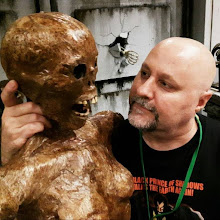As the TV Fangdom conference approaches (which I'll be attending!), I've starting thinking a lot about my favourite vampires on television. As such, I've decided to post a series of blog entries detailing the best and worst of undead TV--beginning with television series. Here are my top ten favourites:
 |
| Barnabas Collins |
Victoria Winters travels to the Collinwood mansion to serve as governess to David Collins, but all is not as it seems in this stately manor home. The strange goings-on take a darker turn upon the arrival of a distant cousin from England, Barnabas Collins, whose friendly façade belies his bloodthirsty nature. This Gothic soap opera was close to cancellation before creator Dan Curtis added supernatural elements into the mix. But the show's popularity skyrocketed after the introduction of Barnabas, a centuries-old vampire, who would become the model for all the self-doubting, romantic undead that followed. Next to Buffy the Vampire Slayer, Dark Shadows has arguably had the greatest impact on popular culture.
 |
| Alexander Lucard |
Dracula has relocated to a major European centre, living under the guise of Alexander Lucard. Now a successful businessman, he's plotting to take over the world's financial institutions. The only one standing in his way is Gustav Helsing, who knows of Lucard's true nature, and is looking for some way to expose him. But things get complicated upon the arrival of Helsing's nephews, Max and Christopher. Even though this series was made for kids, adults will still enjoy it--yet they may find some of the storylines and acting a little too camp.
 |
| Bill & Sookie |
Thanks to the synthetic blood product Tru Blood, vampires have come out of the coffin, and are freely living among the human population. In the small town of Bon Temps, Louisiana, the life of barmaid Sookie Stackhouse changes forever upon the arrival of Bill Compton, a vampire who has returned home in search of his roots. This series started out very strong, and would have scored higher had it ended around season 3. But the plethora of sex, blood and violence--despite being interesting to watch--will never make up for the fact that there's nothing new left to tell.
 |
| Henry Fitzroy |
Private eye Vicki Nelson has a fateful run-in with Henry Fitzroy, a graphic novelist who also happens to be a vampire--and is the illegitimate son of Henry VIII. They team up to solve a series of supernatural crimes in Toronto, along with Vicki's Goth-loving assistant Coreen, and her reluctant ex-partner Detective Mike Celluci. This short-lived Canadian series, based on the "Blood Books" by Tanya Huff, features an interesting cast of characters and strong storytelling. Unfortunately, it only lasted a single season.
 |
| Vampire Jack |
Detective Michael Colefield's best friend Jack has been turned into a vampire. As he searches for answers, Colefield reluctantly joins a paramilitary organization with ties to the Vatican. The group's mission is threefold: track the undead, discover their agenda, and eliminate them if necessary. But the Detective soon realizes that the vampires may not be the real threat. This is an excellent British series (a single season of 6 episodes), and features Stephen Moyer as Jack, a decade before he became known to most of us as Vampire Bill.
 |
| Nick Knight |
Eight-hundred-year-old vampire Nick Knight is atoning for his past misdeeds by working as homicide detective in Toronto. His one human confidant, Dr. Natalie Lambert, is trying to restore his mortality through modern science. This ground-breaking series was the first of the "vampire cop" subgenre, and despite being a fan favourite, it was continually threatened by cancellation. To this day, Nick, Janette (his former flame) and Lacroix (their maker) remain the most interesting trio of bloodsuckers on television.
 |
| Count Dracula |
After his wife leaves him for a werewolf, Count Dracula relocates with his children to a small town in Britain. With the help of their bumbling servant Renfield, and a talking, stuffed wolf named Zoltan, the family tries to adjust to their strange new lives abroad. This exceptional comedy series is suitable for all ages, and features a quirky group of characters led by the head of the household, Count Dracula. He's a fish out of water, who still tries to be the embodiment of evil despite being distracted by the modern trappings of his new surroundings.
 |
| Hal Yorke |
Three 20-somethings share a flat in contemporary Bristol, each hiding a dark secret: Mitchell is a vampire who has sworn off human blood; George is an intelligent man cursed with lycanthropy; and Annie is the ghost of a woman who died in the flat under mysterious circumstances. Together, the three attempt to blend into society and live out their lives as normal human beings. This is one of the most notable series since Buffy, and is a deft mix of horror, humour and pathos. By the end of the fourth season, all original cast members had left the show. Yet somehow the series successfully rebooted itself with three new leads, including Hal, a centuries-old bloodsucker with obsessive-compulsive disorder. He's one of the most fascinating vampire characters depicted on TV; unfortunately, his story ended with the cancellation of the show after the fifth season.
 |
| Buffy Summers |
Even though she's been chosen by fate to be The Slayer (a warrior with heightened abilities who battles supernatural evil), Buffy Summers wants to defy destiny and just be a normal teenager. But her hopes are dashed after she learns that her high school is located atop a portal to hell--and the city quickly becomes a centre of evil activity. This ground-breaking series was responsible for the resurgence of vampires on TV, and Buffy has become a cultural icon in her own right. Although the undead were the catalyst, the stories told were not limited to these creatures alone, which gave writers the freedom to explore contemporary issues facing society. The show has become so significant that one can almost categorize the history of vampires on television as "pre-Buffy" and "post-Buffy."
 |
| Angel |
Angel, the vampire with a soul, teams up with Doyle, a half-demon who receives painful premonitions of future events from The Powers That Be. Along with fledgling actress Cordelia Chase, the three form Angel Investigations, and vow to "help the helpless" of Los Angeles. This Buffy spin-off is darker and grittier that its precursor, and is a shining example of television drama at its best, supernatural or otherwise. Even though the series struggled with the story at times, it had many high points, and concluded with a bang. The ending stayed true to the theme of the show, and was both a heartbreaking and fitting conclusion to this gem of a series.
Honourable mention:
- Sanctuary
(2008-11): The first season explored an interesting and refreshing take on the effects of vampire blood, but subsequent seasons spiraled into a mess of rehashed storytelling. The most notable character is the vampire Nikola Tesla; he's witty, self-absorbed, and has charisma to spare.
- The Munsters
(1964-66): A family of friendly monsters live their lives as normal Americans, never quite understanding why people act so strangely towards them. Features the iconic vampires Lily and Grandpa, who round out a fun cast of oddball characters.
- Cliffhangers! (1979): The "Curse of Dracula" segment features the famous Count, who now lives in present-day San Francisco, working under the assumed identity of a college professor. He secretly longs for the daughter of a woman he once loved, but she's trying to destroy him with the help of Kurt von Helsing (the grandson of the renowned vampire hunter).







0 comments:
Post a Comment